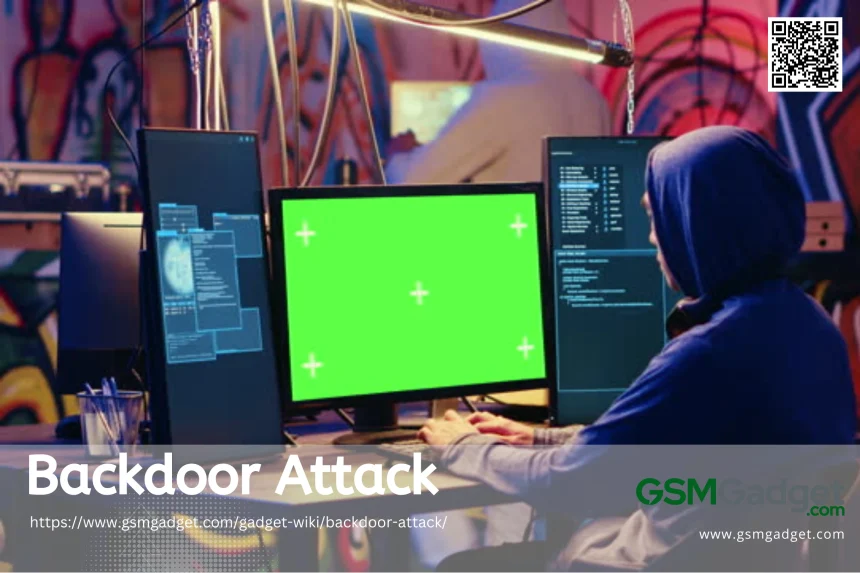A Backdoor Attack is a sophisticated cyber threat against deep learning models. In this attack, an adversary manipulates the training process by introducing poisoned data. This poisoned data contains a secret trigger that, when presented during the model’s operation, causes the model to make incorrect predictions. Backdoor attacks are dangerous because they can remain undetectable during normal model performance on clean data. The model behaves normally until the trigger is activated, leading to severe security breaches. Defending against these attacks is challenging because the poisoned data can appear natural and correctly labeled, making it hard to identify and mitigate the threat.
| Specification Detail | Description |
| Attack Type | Backdoor Attack |
| Objective | To gain unauthorized access to a system or network by bypassing security mechanisms. |
| Common Targets | Software, firmware, hardware, or network systems. |
| Infection Methods | Phishing, software vulnerabilities, social engineering, supply chain compromise. |
| Persistence | Backdoors are designed to remain hidden and maintain long-term access. |
| Stealth Techniques | Use of rootkits, encryption, mimicking legitimate processes, altering logs to avoid detection. |
| Access Level | Often provides administrative or root-level access. |
| Remote Control | May allow attackers to control the system remotely. |
| Data Exfiltration | Can be used to steal sensitive data. |
| Potential Indicators | Unusual system behavior, unexpected network traffic, unknown processes or services. |
| Defense Strategies | Regular software updates, intrusion detection systems, network monitoring, employee training. |
| Removal Difficulty | Can be difficult to remove; may require system reinstallation or hardware replacement. |
| Legal Implications | Unauthorized access and data theft can lead to legal consequences under various cyber laws. |
| Impact | Can lead to loss of data, compromised security, financial loss, and damage to reputation. |
Types of backdoor Attack commonly used by attackers
Backdoor attacks are a form of cyber intrusion where attackers gain unauthorized access to a system, bypassing normal security mechanisms. Common types of backdoor attacks include those that exploit software vulnerabilities, such as:
- Trojans: which are malicious programs disguised as legitimate software.
- Rootkits: which are tools that can hide the presence of malware or the attacker’s activity on the system.
- Backdoor shells: which are scripts uploaded to a server to allow remote administration.
- Remote File Inclusion (RFI): to execute remote files via web applications, or they might insert malicious code during the development phase of software, creating a built-in backdoor from the outset.
- Hardware: These are physical vulnerabilities embedded in hardware devices, such as routers or switches, which can be exploited to gain unauthorized access to networks or devices.
- Cryptojacking: Cryptojacking backdoors hijack computing resources to mine cryptocurrency without the user’s consent. This type of backdoor can affect various devices and systems.
- Ransomware: This type of backdoor encrypts or locks out the data on a victim’s system and demands a ransom to restore access. It is a direct way to monetize the attack.
- Spyware: Spyware backdoors collect and transmit personal or sensitive information without the user’s knowledge. This can include keylogging, where keystrokes are recorded to steal passwords and other sensitive data.
Techniques used to establish Backdoor Attack in systems
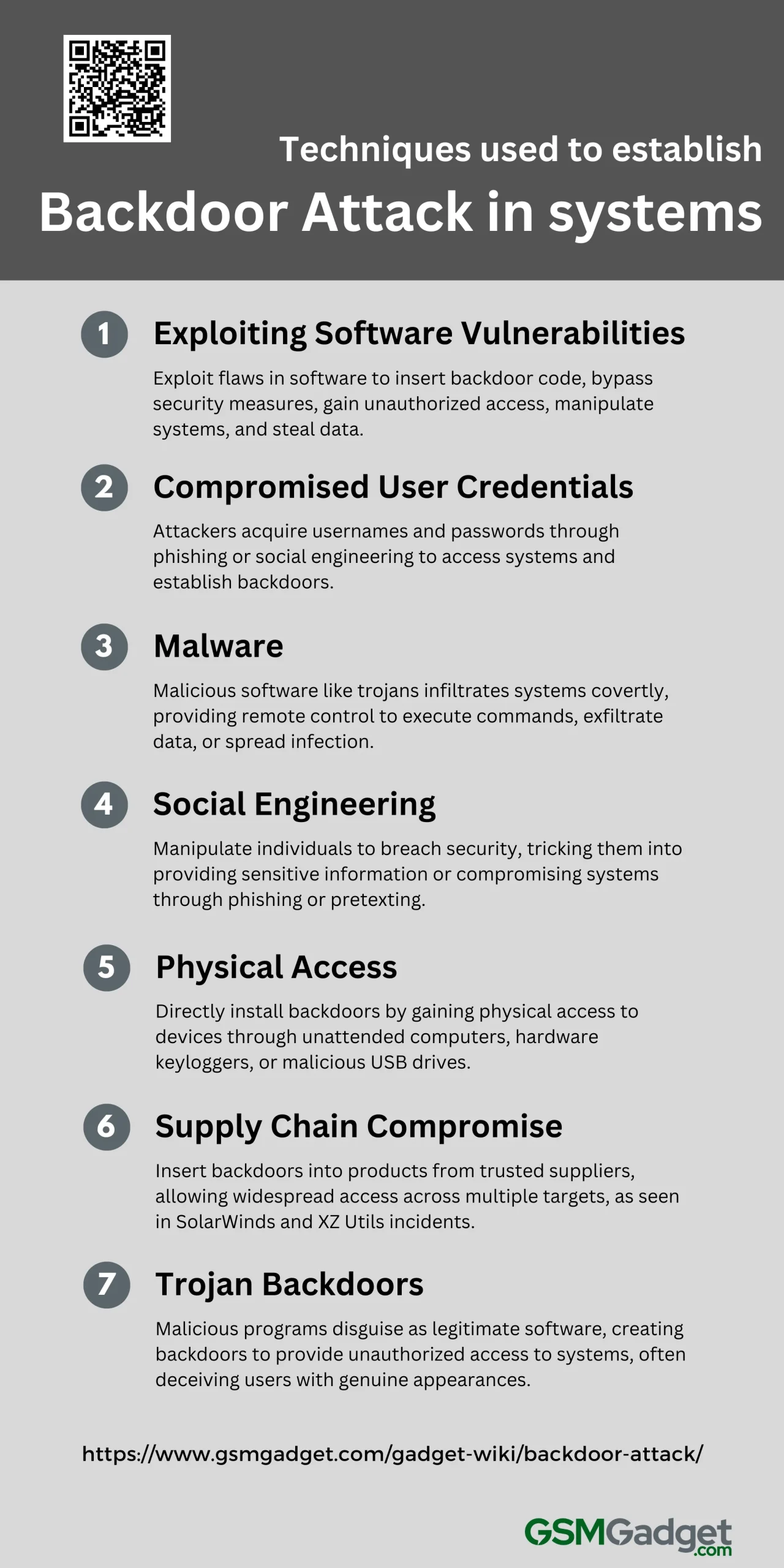
1. Exploiting Software Vulnerabilities
Backdoor attacks often exploit software vulnerabilities to bypass normal security measures. Attackers target flaws in software to insert backdoor code, allowing them unauthorized access without detection. These vulnerabilities can be in operating systems, applications, or network protocols. Once exploited, these vulnerabilities can give attackers the same rights as legitimate users, enabling them to manipulate systems, steal data, or deploy additional malware. Regular software updates and patches are crucial to mitigate these risks by closing known vulnerabilities.
2. Compromised User Credentials
Compromised user credentials are a common vector for backdoor attacks. Attackers use various methods such as phishing, credential stuffing, or social engineering to acquire usernames and passwords. Once they have these credentials, they can access systems as legitimate users and establish backdoors for ongoing access. This method is particularly effective because it can bypass many traditional security measures that rely on user authentication. To combat this, organizations implement strong password policies, two-factor authentication, and continuous monitoring of account activities.
3. Malware
Malware is a primary tool used in backdoor attacks. Types of malware like trojans, worms, and rootkits are designed to covertly infiltrate systems and create backdoors. These malicious programs can be delivered via email attachments, compromised websites, or direct downloads. Once installed, they provide attackers with remote control over the system, allowing them to execute commands, exfiltrate data, or further spread the infection. Effective antivirus solutions and intrusion detection systems are essential to identify and remove such threats.
4. Social Engineering
Social engineering involves manipulating individuals into breaking security protocols to gain unauthorized system access. Attackers often pose as trusted entities to trick users into providing sensitive information or performing actions that compromise security. Techniques include phishing, pretexting, and baiting. Since this method exploits human psychology rather than technical vulnerabilities, training and awareness programs are critical in helping individuals recognize and resist such tactics.
5. Physical Access
Gaining physical access to a device can allow attackers to directly install backdoors. This can be achieved through tactics like accessing unattended computers, using hardware keyloggers, or through USB drives loaded with malicious software. Physical security measures such as secure facilities, restricted access, and device encryption play crucial roles in preventing such attacks. Additionally, policies that control the use of removable media are important to mitigate risks from devices that may carry malicious payloads.
6. Supply Chain Compromise
Supply chain attacks involve compromising software or hardware from trusted suppliers to distribute backdoors. By inserting malicious code into products before they reach the customer, attackers can gain widespread access across multiple targets who use the compromised products. Notable examples include the SolarWinds and XZ Utils incidents. Organizations must rigorously vet their suppliers and monitor for anomalies in third-party products and services to defend against these sophisticated attacks.
7. Trojan Backdoors
Trojan backdoors are malicious programs that disguise themselves as legitimate software. Once installed, they create a backdoor, giving attackers unauthorized access to the affected system. Trojans can be particularly deceptive as they often come bundled with or mimic genuine software, making them hard to detect. Users must be cautious about downloading software from unverified sources and should rely on reputable antivirus tools to detect and remove such threats.
Common indicators that a system has been compromised by a Backdoor Attack
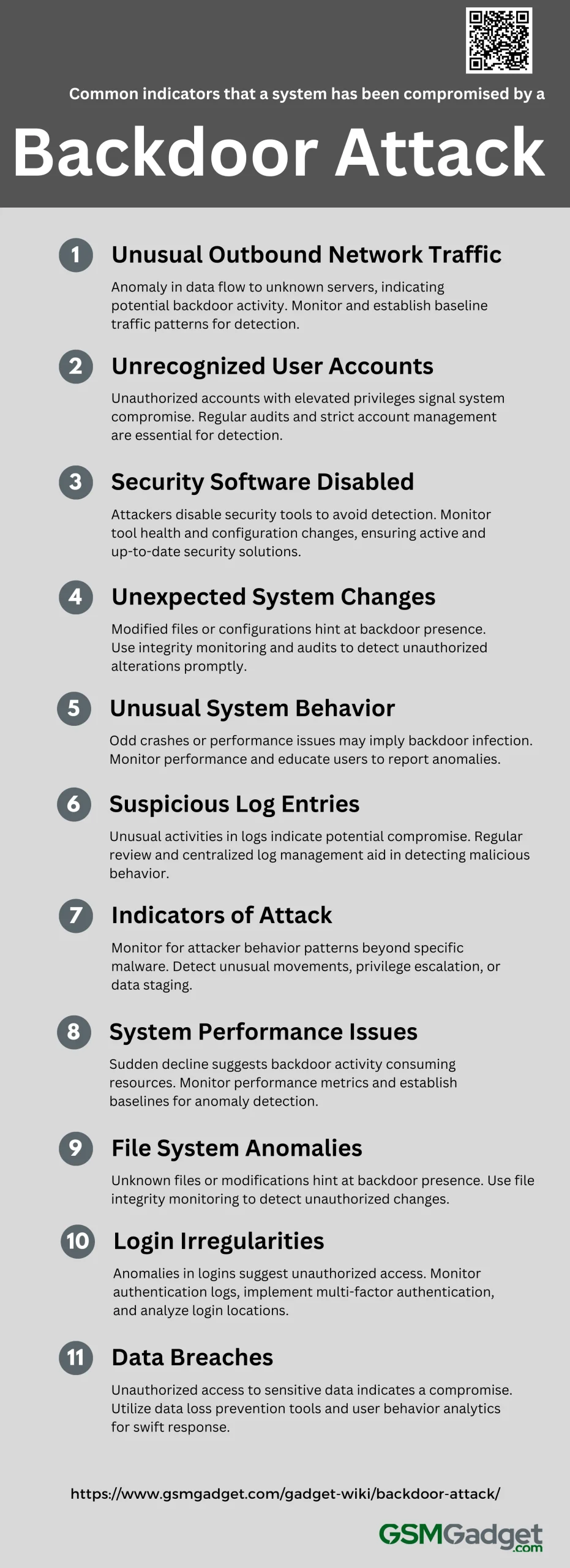
1. Unusual Outbound Network Traffic
Unusual outbound network traffic is a significant indicator of a backdoor attack. This anomaly can manifest as unexpected data flows to external servers, especially to unfamiliar or suspicious IP addresses. Attackers often use backdoors to exfiltrate sensitive data, communicate with command and control servers, or download additional malicious payloads. Monitoring network traffic patterns for deviations from the norm can help identify unauthorized data transmissions, signaling a potential compromise. Organizations should employ network monitoring tools and establish baseline traffic patterns to quickly detect and respond to such irregularities.
2. Unrecognized User Accounts
The creation of unrecognized user accounts is a common tactic used by attackers to maintain access to a compromised system. These accounts often have elevated privileges, allowing attackers to execute commands, access sensitive data, and persist within the network undetected. Regular audits of user accounts and permissions can help identify unauthorized accounts, especially those created outside of standard provisioning processes. Organizations should implement strict account management policies and employ identity and access management solutions to detect and prevent the unauthorized creation of user accounts.
3. Security Software Disabled
Attackers frequently target security software to disable or evade detection mechanisms. This can include antivirus programs, firewalls, and intrusion detection systems. Disabling these tools allows attackers to operate without triggering alerts that could lead to their discovery and removal. Monitoring the health and operational status of security solutions is crucial for maintaining system integrity. Organizations should configure security software to alert administrators of any changes to its status or configuration and regularly verify that all security tools are active and up-to-date.
4. Unexpected System Changes
Unexpected system changes, such as modified files, new services, or altered configurations, can indicate the presence of a backdoor. Attackers may modify system settings to facilitate their activities, create persistence mechanisms, or disable security controls. Implementing file integrity monitoring and configuration management tools can help detect unauthorized changes to critical system components. Regular system audits and employing a change management process are also effective strategies for identifying and investigating unexplained modifications.
5. Unusual System Behavior
Unusual system behavior, such as frequent crashes, slow performance, or unexpected pop-ups, can be symptomatic of a backdoor infection. These behaviors may result from the execution of malicious processes or the strain placed on system resources by the attacker’s activities. Monitoring system performance and logging unusual events can aid in the early detection of compromise. Organizations should also educate users to report any erratic system behavior, as this can be an early warning sign of a security breach.
6. Suspicious Log Entries
Suspicious log entries, such as failed login attempts, unauthorized access to sensitive files, or unusual administrative activities, can indicate that a system has been compromised through a backdoor. Attackers may leave traces of their activities in system, application, and security logs. Regular log review and analysis are essential for identifying signs of malicious activity. Employing centralized log management and security information and event management (SIEM) solutions can facilitate the detection of suspicious log entries across the network.
7. Indicators of Attack (IOAs)
Indicators of Attack (IOAs) focus on detecting the intent of what an attacker is trying to accomplish, regardless of the malware or exploit used in an attack. IOAs can include patterns of behavior that suggest an attacker is progressing through the cyber kill chain. For example, unusual lateral movements within the network, escalation of privileges, or data staging areas can all be IOAs that a backdoor is being used. Proactively monitoring for IOAs can help organizations detect and respond to attacks earlier in the attack lifecycle.
8. System Performance Issues
A sudden decline in system performance may indicate that a backdoor has been installed. Attackers can use backdoors to launch processes that consume a significant amount of system resources, such as CPU, memory, or network bandwidth. These activities can lead to noticeable performance degradation, including slow application response times or system unresponsiveness. Implementing performance monitoring tools and establishing performance baselines can help identify anomalies that may suggest a system compromise.
9. File System Anomalies
File system anomalies, such as the presence of unknown files or directories, unexpected file modifications, or the deletion of logs, can signal a backdoor attack. Attackers may drop additional tools or payloads onto the compromised system, modify existing files to embed malicious code, or attempt to cover their tracks by deleting logs. Utilizing file integrity monitoring solutions can alert administrators to unauthorized changes to the file system, aiding in the detection of malicious activity.
10. Login Irregularities
Irregularities in login patterns, such as logins at unusual times, repeated failed login attempts, or logins from unexpected locations, can indicate that an attacker has gained access through a backdoor. Monitoring authentication logs for anomalies can help identify unauthorized access attempts. Implementing multi-factor authentication and geographic location analysis on login attempts can also reduce the risk of unauthorized access through compromised credentials.
11. Data Breaches
A data breach is often a clear indicator that a system has been compromised, potentially through a backdoor. Unauthorized access to sensitive data, such as customer information, intellectual property, or financial records, can have significant consequences. Detecting a breach requires a combination of data loss prevention (DLP) tools, network monitoring, and user behavior analytics to identify unauthorized data access or exfiltration activities. Swiftly responding to a data breach is critical for minimizing damage and preventing further unauthorized access.
How to detect and mitigate backdoor attacks
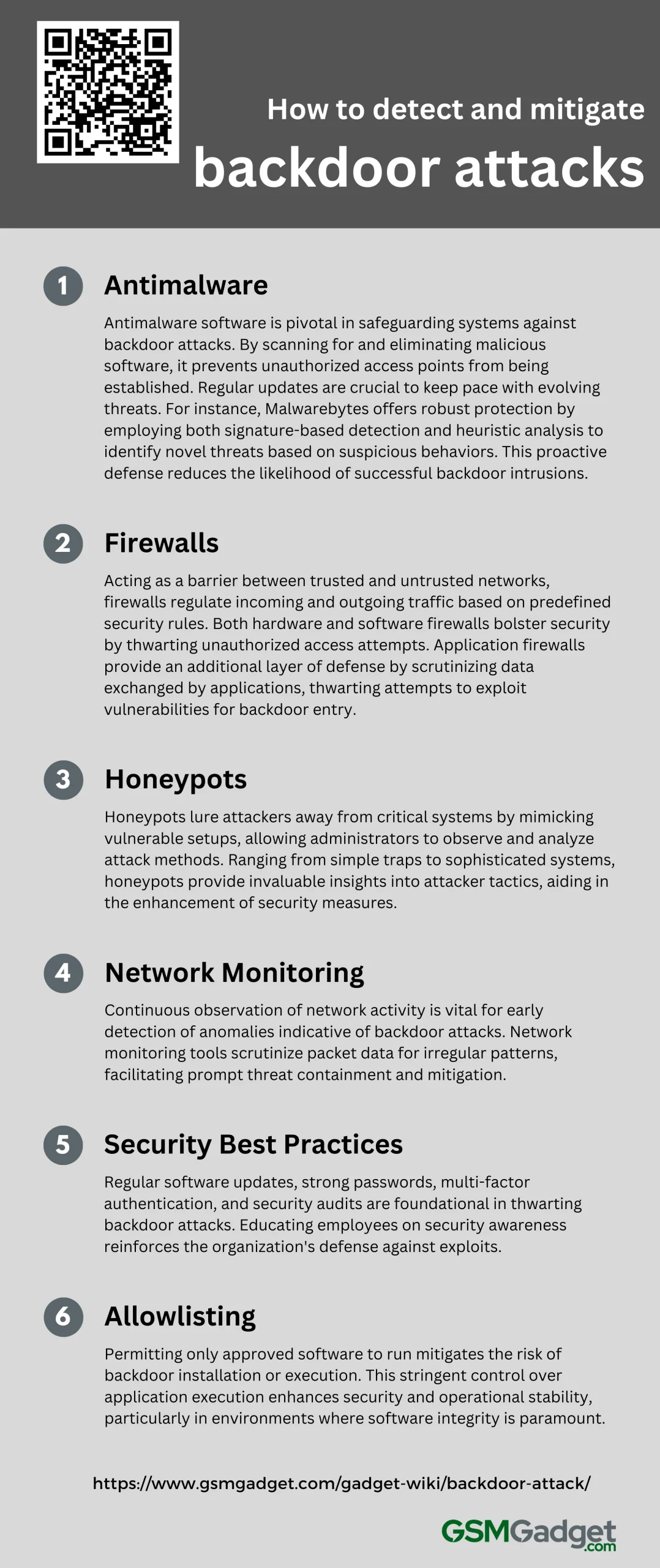
1. Antimalware
Antimalware software plays a crucial role in detecting and preventing backdoor attacks by scanning for and removing malicious software that could create unauthorized access points in a system. These tools are equipped with databases of known threats and use heuristic analysis to detect new, unknown threats by examining suspicious behaviors. Regular updates are essential to ensure that antimalware tools can recognize the latest backdoor threats. For instance, Malwarebytes offers comprehensive protection by detecting and removing backdoors without user intervention, significantly reducing the risk of a successful attack.
2. Firewalls
Firewalls act as a barrier between a trusted network and untrusted networks, monitoring and controlling incoming and outgoing network traffic based on predetermined security rules. Both hardware and software firewalls can prevent unauthorized access by blocking potentially malicious traffic and closing ports that might be used for backdoor entries. Application firewalls go further by inspecting the data being sent to and from applications, ensuring that malicious software does not exploit application vulnerabilities to bypass network security measures.
3. Honeypots
Honeypots are decoy systems or data setups that attract attackers while diverting them from actual network resources. They are designed to mimic the behavior of real systems that appear vulnerable and enticing to attackers. By engaging attackers, honeypots help administrators study attack methods and track intruder activities without risking critical system components. This information can be used to enhance security measures and understand new threats. Honeypots vary in complexity from simple traps to highly interactive systems that can engage sophisticated hackers.
4. Network Monitoring
Network monitoring involves the continuous observation of a network’s activity to detect and respond to anomalies that may indicate a backdoor or other security threats. Tools like network analyzers and protocol monitors inspect packet data traveling through the network, looking for unusual patterns such as unexpected outbound connections or abnormal volumes of data transfer, which could suggest the presence of a backdoor. This proactive approach helps in early detection, allowing for quick containment and mitigation of threats.
5. Security Best Practices
Implementing security best practices is fundamental to protecting against backdoor attacks. This includes regularly updating and patching software to close security loopholes, using strong, unique passwords, and employing multi-factor authentication to enhance access security. Organizations should also conduct regular security audits and vulnerability assessments to identify and mitigate risks. Educating employees about security awareness and safe computing practices can further reduce the risk of backdoor exploits.
6. Allowlisting
Allowlisting is a security measure that permits only approved software to run on a system while blocking all others. This approach can effectively prevent unauthorized applications, which might contain backdoors, from being installed or executed. By controlling application execution and ensuring only trusted software is allowed, organizations can significantly reduce the risk of backdoor attacks. This method is particularly effective in environments where the integrity of software is critical to security and operational stability.
Notable cases of backdoor attacks in the past
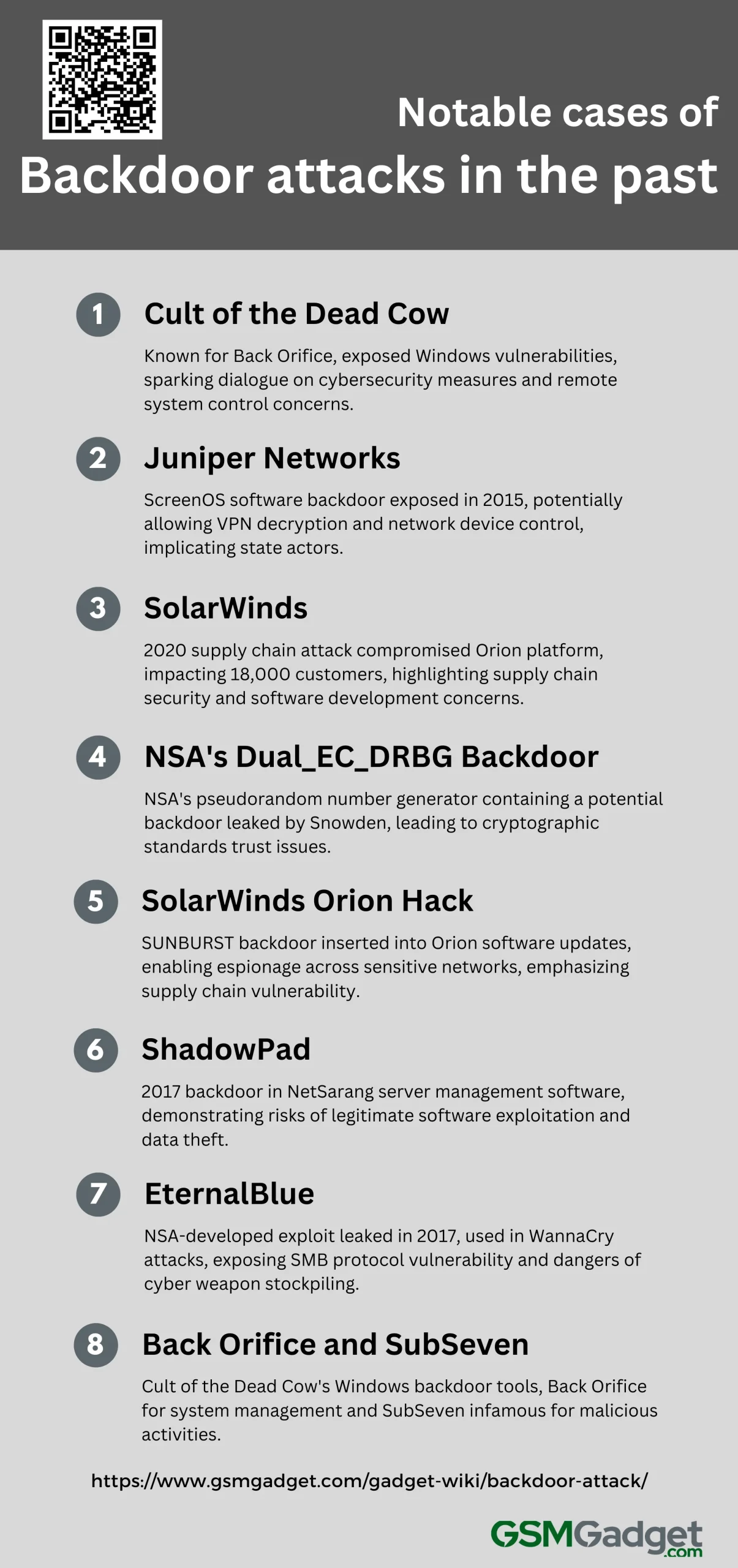
1. Cult of the Dead Cow
The Cult of the Dead Cow (cDc) is a prominent hacking group known for its influence on internet activism and the development of hacking tools. Founded in 1984, the group gained notoriety for creating Back Orifice, a remote administration tool that exposed vulnerabilities in Microsoft Windows operating systems. This tool demonstrated how easily malicious actors could control a system remotely, raising significant concerns about digital security and inspiring further dialogue on the need for robust cybersecurity measures.
2. Juniper Networks
In 2015, Juniper Networks, a major provider of networking equipment, disclosed that unauthorized code had been inserted into its ScreenOS software, affecting its NetScreen firewalls. This code could potentially allow an attacker to decrypt VPN traffic and gain administrative access to the network devices. The backdoor was believed to have been in place since 2012. Investigations suggested that this vulnerability might have been exploited by state actors, highlighting the risks of sophisticated backdoors in critical network infrastructure.
3. SolarWinds
The SolarWinds attack, uncovered in 2020, was a sophisticated and stealthy supply chain attack that compromised the Orion software platform. Malicious code was inserted into software updates sent to as many as 18,000 customers, including U.S. government agencies and Fortune 500 companies. This breach allowed attackers to spy on the internal operations of affected organizations, leading to a significant reevaluation of security practices for software development and supply chain management.
4. NSA’s Dual_EC_DRBG Backdoor
Dual_EC_DRBG, a pseudorandom number generator promoted by the NSA, was revealed to contain a potential backdoor. This vulnerability could theoretically allow the NSA to decrypt information that was encrypted using the compromised generator. The backdoor allegations were confirmed by documents leaked by Edward Snowden, leading to widespread criticism and loss of trust in the NSA’s involvement in cryptographic standards.
5. SolarWinds Orion Hack
The SolarWinds Orion hack, part of the broader SolarWinds supply chain attack, specifically targeted the Orion platform, a widely used network management system. The attackers managed to insert a backdoor called “SUNBURST” into software updates, which then allowed them to conduct espionage and potentially disrupt operations across various sensitive and critical networks. This incident underscored the vulnerability of supply chains and the far-reaching impacts of security breaches in widely used software.
6. ShadowPad
ShadowPad is an example of a sophisticated backdoor discovered in 2017 within software used by hundreds of large companies globally. It was hidden in a server management software developed by NetSarang. Once activated, the backdoor could download further malicious modules or steal data from the compromised computer. This attack highlighted the risks posed by malicious code embedded within legitimate software updates, echoing concerns similar to those raised by the SolarWinds incident.
7. EternalBlue
EternalBlue was a cyberattack exploit developed by the NSA that was leaked by the Shadow Brokers hacker group in 2017. It exploits a vulnerability in Microsoft’s implementation of the Server Message Block (SMB) protocol. This exploit was used in the infamous WannaCry ransomware attacks, which affected thousands of computers worldwide, including critical infrastructure in various countries. EternalBlue’s release and subsequent misuse demonstrated the dangers of stockpiling cyber weapons.
8. Back Orifice and SubSeven
Back Orifice and SubSeven are notorious examples of early backdoor software primarily targeting Windows operating systems. Developed by the Cult of the Dead Cow, Back Orifice was designed to expose the security deficiencies of Windows 98 and allow remote system management. SubSeven was similar but became more infamous for its use in malicious activities. Both tools highlighted the ease with which malicious actors could gain unauthorized access to vulnerable systems and were pivotal in raising awareness about the need for better security practices.
Methods of removing backdoors attacks
It’s crucial to run comprehensive anti-malware scans using updated tools to detect and remove any malicious software that might be present. If the backdoor is deeply embedded, such as in the firmware or operating system, a complete reinstallation of the OS from a trusted source may be necessary. For hardware-based backdoors, replacing compromised components like network cards or motherboards might be required. Additionally, updating all software and firmware to the latest versions can close vulnerabilities that might have been exploited to install the backdoor. Regular monitoring of network traffic and system logs can help detect any unusual activity that might suggest the presence of a backdoor, ensuring ongoing vigilance against further attacks.
- Run anti-malware programs
- Perform a full system reset
- Manually remove malware
- Manual Code Analysis
- System Restoration and Reinstallation
- Network Monitoring and Analysis
- Updating and Patching
- Changing Default Credentials
- Professional Cybersecurity Assistance
Preventing Backdoor Attacks
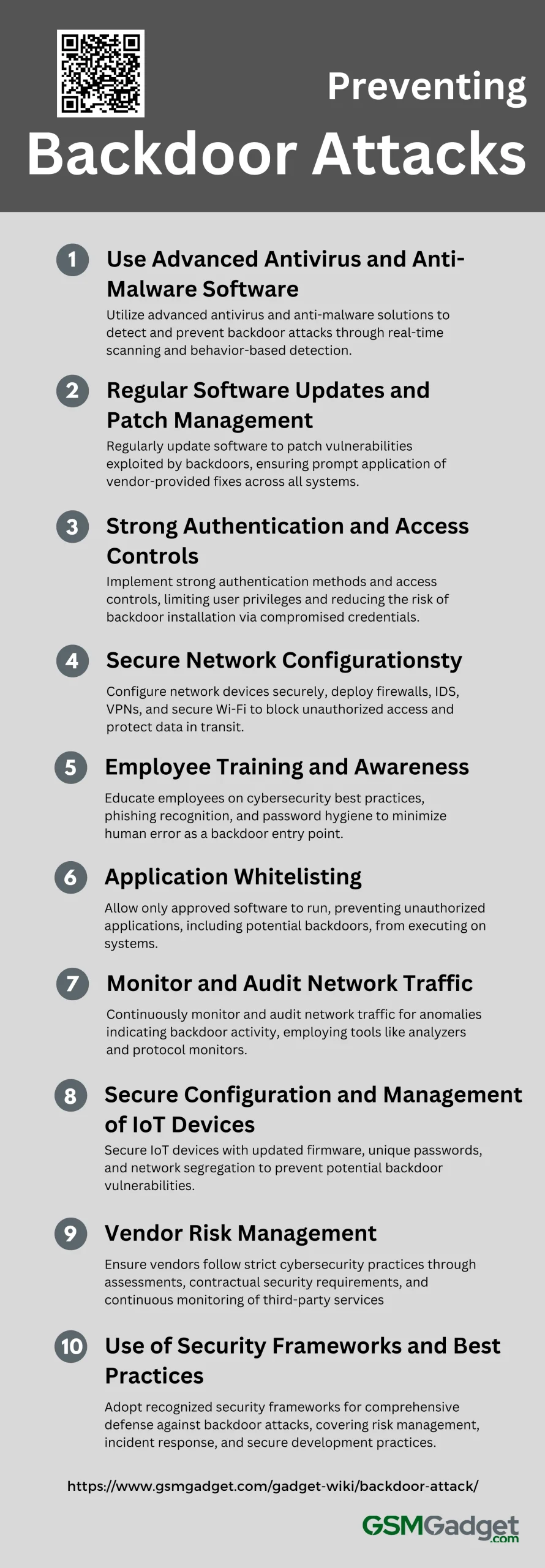
1. Use Advanced Antivirus and Anti-Malware Software
Implementing advanced antivirus and anti-malware solutions is crucial for detecting and preventing backdoor attacks. These software programs are designed to scan and monitor systems for malicious activities and known signatures of backdoor malware. They also provide real-time protection against emerging threats by using heuristic and behavior-based detection technologies, which can identify and block malware that traditional signature-based methods might miss.
2. Regular Software Updates and Patch Management
Keeping software up-to-date is essential in protecting against backdoor attacks. Cybercriminals often exploit vulnerabilities in outdated software to install backdoors. Regular updates and patch management ensure that these vulnerabilities are fixed before they can be exploited. This process involves regularly checking for updates from software vendors and applying them promptly to all systems and applications within the organization.
3. Strong Authentication and Access Controls
Implementing strong authentication methods, such as two-factor authentication (2FA) and multi-factor authentication (MFA), adds an extra layer of security, making unauthorized access more difficult. Access controls should also be enforced to limit user access to the minimum necessary for their job functions. This practice, known as the principle of least privilege, reduces the risk of a backdoor being installed through compromised credentials.
4. Secure Network Configurations
Properly configuring network devices and using firewalls and intrusion detection systems (IDS) can significantly enhance security against backdoor attacks. Firewalls block unauthorized access, while IDS monitor network traffic for suspicious activities. Additionally, using Virtual Private Networks (VPNs) and secure Wi-Fi configurations can protect data in transit and prevent intercepts that could lead to backdoor installations.
5. Employee Training and Awareness
Human error is a common entry point for many cyber attacks. Providing regular training on cybersecurity best practices and current threats can empower employees to recognize and avoid potential backdoors. Topics should include phishing recognition, safe internet practices, and the importance of using strong, unique passwords. Simulated phishing exercises can also help reinforce this training by providing practical experience in spotting malicious attempts.
6. Application Whitelisting
Application whitelisting is a security measure that allows only pre-approved software to run on a system. This approach can prevent unauthorized applications, which could potentially contain backdoors, from being installed or executed. Whitelisting ensures that only software that has been vetted for security is used within the organization, significantly reducing the risk of malicious attacks.
7. Monitor and Audit Network Traffic
Continuous monitoring and auditing of network traffic allow for the detection of unusual activities that could indicate a backdoor. Tools like network analyzers and protocol monitors can identify abnormal data flows and unauthorized access attempts. Regular audits help ensure that no security breaches have occurred and that the preventive measures in place are effective.
8. Secure Configuration and Management of IoT Devices
IoT devices can be vulnerable to backdoor attacks if not properly secured. It’s important to change default passwords, regularly update firmware, and monitor these devices continuously. Segregating IoT devices on separate network zones can also prevent potential attackers from accessing critical data systems if a device is compromised.
9. Vendor Risk Management
Organizations must ensure that their vendors follow strict cybersecurity practices to prevent backdoors that could affect supplied products or services. This involves conducting regular security assessments of vendors, establishing clear security requirements in contracts, and continuously monitoring the security posture of third-party services.
10. Use of Security Frameworks and Best Practices
Adopting recognized security frameworks, such as ISO 27001, NIST, or CIS Controls, provides structured guidance on implementing comprehensive security measures. These frameworks offer best practices that help in establishing a robust defense against various cyber threats, including backdoor attacks. They cover areas such as risk management, incident response, and the secure development lifecycle of software.
